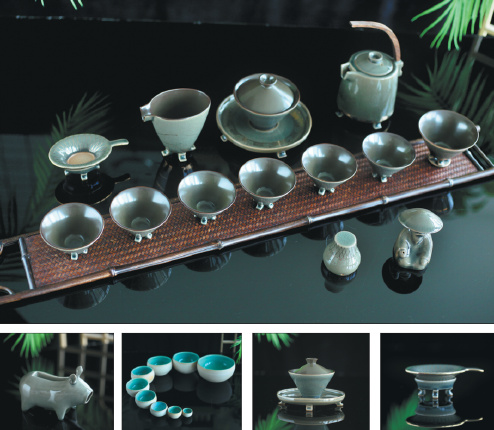

Craftsman's colored glaze products combine innovation and history, Li Yingxue reports.
Xin Zhaoguo felt a sense of nervous anticipation as he prepared to open the kiln. Just one day earlier, he had carefully placed 200 cups inside and fired them for a full 10 hours.
Now, after allowing the interior to cool, it was finally time to reveal the results.
He couldn't help but feel excited at the prospect of seeing his new creations.
It was this element of surprise that made Xin's work more rewarding. "That is the special thing about colored glaze — you will never know if you have been successful or not until you open the kiln," Xin explains.
"The charm of colored glaze is in its unpredictability, with each piece taking on a unique pattern and hue that can never be replicated," he says.
Xin, 48, is an inheritor of Zibo-style colored glaze, an intangible cultural heritage of the city in Shandong province. It's a traditional Chinese ceramic craft which is renowned for its unique and vibrant colors.
Originating in the Song Dynasty (960-1279), colored glaze has become an important calling card for folk art in Zibo. It was popular in the 1980s and the '90s and products were sold to overseas markets. However, in the past two decades, fewer people have continued engaging in the handicraft, as it is not easy to make a living.
With more than three decades of experience in this field, Xin has won multiple prizes with his unique colored glaze creations. He is designing more new products to explore greater possibilities of this traditional Chinese skill, as well as trying to spark the interest of younger customers.
Together with his wife Zhao Zengxia, Xin is also gathering other local intangible cultural heritage inheritors in Zibo to better preserve these traditional skills through research, communication and collaboration.

Born in Zibo, Xin was introduced to ceramics at a young age due to his family's involvement with the traditional craft. His father, uncles and grandfather were all renowned color glaze masters, and he learned his skills from them.
Xin remembers watching his father and uncles making pottery every day, and observing in amazement that a lump of clay could transform into vessels of different shapes in their hands, as if by magic.
Driven by this curiosity, Xin developed a strong interest in clay. With his keen eye, Xin learned the pottery making techniques by observing and assisting his family with tasks such as trimming, glazing and firing.
The process of creating the Zibo-style pottery involves applying various colored glazes onto the surface of the ceramic during production, which are then fired at high temperatures to create an artistic effect.